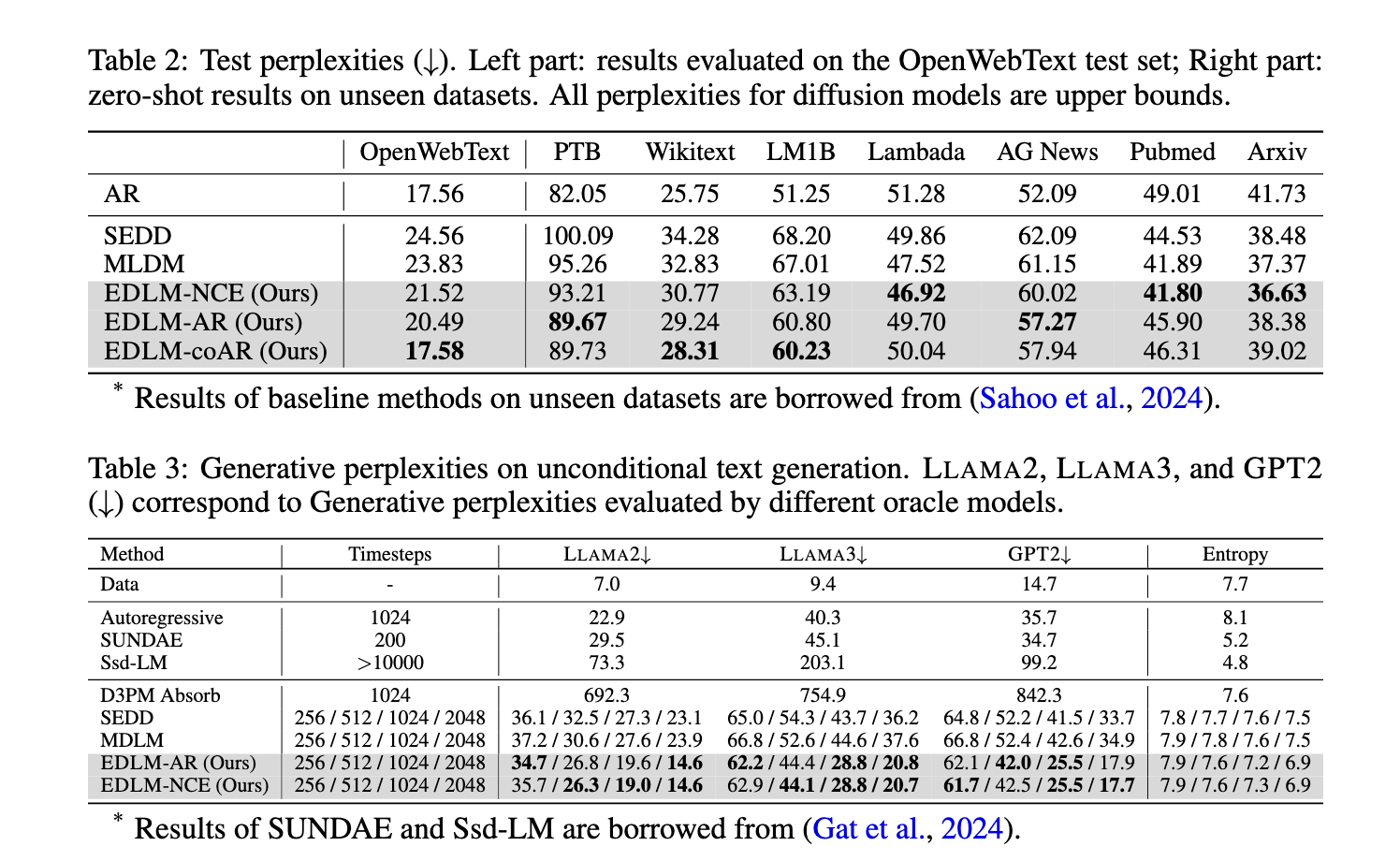Recent advances in generative language modeling have boosted natural language processing, making it possible to create contextually rich and coherent text in various applications. Autoregressive (AR) models generate text in a left-to-right sequence and are widely used for tasks such as coding and complex reasoning. However, these models face limitations due to their sequential nature, making them vulnerable to the accumulation of errors at each step. Relying on a strict order to generate tokens can restrict flexibility in sequence generation. To address these drawbacks, researchers have begun to explore alternative methods, particularly those that allow parallel generation, allowing text to be created more easily and efficiently.
A critical challenge in language modeling is the progressive accumulation of errors inherent in autoregressive approaches. As each generated token depends directly on the previous ones, minor initial errors can cause significant deviations, affecting the quality of the generated text and reducing efficiency. Addressing these issues is crucial, as the accumulation of errors decreases the accuracy and limits the usability of AR models for real-time applications that demand high-speed and reliable results. Therefore, researchers are investigating parallel text generation to maintain high performance while mitigating errors. Although parallel generation models have shown promise, they often need to match the detailed contextual understanding achieved by traditional AR models.
Currently, discrete diffusion models stand out as an emerging solution for parallel text generation. These models generate entire sequences simultaneously, offering significant speed benefits. Discrete diffusion models start from a completely masked sequence and progressively discover tokens non-sequentially, enabling bidirectional text generation. Despite this capability, current diffusion-based approaches face limitations due to their reliance on independent token predictions, which ignore dependencies between tokens. This independence often results in lower precision and the need for multiple sampling steps, leading to inefficiencies. While other models attempt to close the gap between quality and speed, most need help to achieve the accuracy and fluidity that autoregressive settings provide.
Researchers from Stanford University and NVIDIA introduced the Energy-Based Diffusion Language Model (EDLM). EDLM represents an innovative approach that combines energy-based modeling with discrete diffusion to address the inherent challenges of parallel text generation. By integrating an energy function into each stage of the diffusion process, EDLM seeks to correct dependencies between tokens, thus improving the quality of the sequence while maintaining the advantages of parallel generation. The energy function allows the model to learn dependencies within the sequence by leveraging a pre-trained autoregressive model or a bidirectional transformer fine-tuned using contrastive noise estimation. The EDLM architecture therefore fuses diffusion efficiency with the sequence coherence typical of energy-based methods, making it a pioneering model in the field of language generation.
The EDLM framework involves a deep methodology focused on introducing an energy function that dynamically captures correlations between tokens throughout the generation process. This energy function operates as a corrective mechanism within each diffusion step, effectively addressing the challenges associated with token independence in other discrete diffusion models. By taking a residual form, the energy function allows EDLM to iteratively refine predictions. The energy-based framework operates on pre-trained autoregressive models, allowing EDLM to avoid the need for maximum likelihood training, a typically expensive process. Instead, the model's energy function operates directly on the sequence, allowing EDLM to perform efficient parallel sampling through importance sampling, further improving model accuracy. This efficient sampling method reduces decoding errors by optimizing the token dependency mechanism, which distinguishes EDLM from other diffusion-based methods.
EDLM performance evaluations reveal substantial improvements in the speed and quality of text generation. In tests with other models in language tests, EDLM showed up to a 49% reduction in generative perplexity, marking a significant advance in text generation accuracy. Additionally, EDLM demonstrated a 1.3 times faster sampling rate compared to conventional diffusion models, all without sacrificing performance. Benchmark testing further indicated that EDLM approaches the perplexity levels typically achieved by autoregressive models, while maintaining the efficiency benefits inherent to parallel generation. For example, in a comparison using the Text8 dataset, EDLM achieved the lowest bits per character score among the tested models, highlighting its superior ability to maintain text consistency with fewer decoding errors. Furthermore, on the OpenWebText dataset, EDLM outperformed other state-of-the-art diffusion models, achieving competitive performance even against robust autoregressive models.

In conclusion, the novel EDLM approach successfully addresses long-standing issues related to sequential dependency and error propagation in language generation models. By effectively combining energy-based corrections with the parallel capabilities of diffusion models, EDLM presents a model that offers improved accuracy and speed. This innovation by researchers at Stanford and NVIDIA demonstrates that energy-based approaches can play a crucial role in the evolution of language models, providing a promising alternative to autoregressive methods for applications that require high performance and efficiency. EDLM's contributions lay the foundation for more adaptive and context-aware language models that can achieve accuracy and efficiency, underscoring the potential of power-based frameworks to advance generative text technologies.
look at the Paper. All credit for this research goes to the researchers of this project. Also, don't forget to follow us on twitter.com/Marktechpost”>twitter and join our Telegram channel and LinkedIn Grabove. If you like our work, you will love our information sheet.. Don't forget to join our SubReddit over 55,000ml.
(Sponsorship opportunity with us) Promote your research/product/webinar to over 1 million monthly readers and over 500,000 community members
Nikhil is an internal consultant at Marktechpost. He is pursuing an integrated double degree in Materials at the Indian Institute of technology Kharagpur. Nikhil is an ai/ML enthusiast who is always researching applications in fields like biomaterials and biomedical science. With a strong background in materials science, he is exploring new advances and creating opportunities to contribute.
<script async src="//platform.twitter.com/widgets.js” charset=”utf-8″>
 NEWSLETTER
NEWSLETTER





